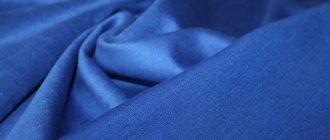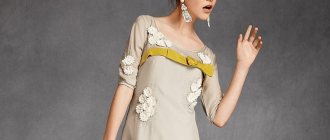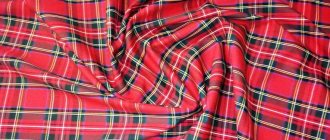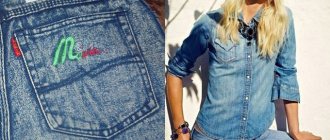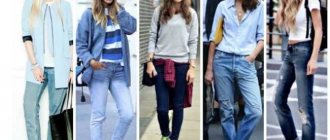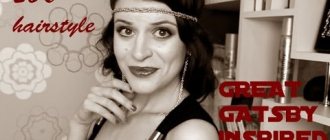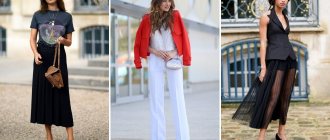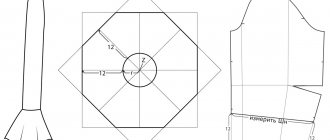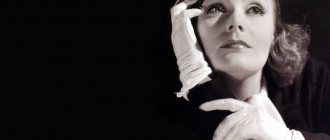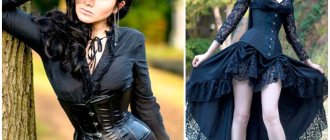Baroque style
The style appeared at the end of the 16th century and dominated the entire 17th century. This is the most luxurious, brightest, most magnificent, most theatrical and pompous style. This is a style of wealth that is not hidden and luxury that is not shy. More gold, more colors! Baroque is provocative, cumbersome, irregular. But despite its irregularity, it is symmetrical, patterned, convex.
Too much. Too much is the key word of the Baroque style.
Agnolo Bronzino. Eleanor of Toledo with her son 1545
Baroque - the first style that united the countries of Europe, made fashionistas and fashionistas from different countries a little similar to each other, since the same ideals prevailed. Europeans like the same clothing models, similar accessories and baroque colors: black, gold. Gold embroidery, voluminous lace, Spanish ruffled collars, which began their march across the fashion map of Europe at the end of the Renaissance and completely conquered all countries during the Baroque era.
Elizabeth of France, later Isabella of Bourbon, Queen of Spain (1602-44)
It is thanks to these corrugated collars that forks and napkins appear in table etiquette in the Baroque era. Lace collars were a luxury item, and not everyone could afford to wear them. That is why there is a need to treat them with care. Using a fork, you could eat without fear of staining your clothes.
And in principle, due to the size of the collar, it was almost impossible to eat without using cutlery. Just imagine, could you have a snack if you had such a collar?
Michael van Mierevelt. Portrait of a Woman 1635
And, of course, the Baroque style is characterized by all kinds of jewelry with pearls. Lots of pearls, pearls of different shapes, large pearls, varied use of pearls in different decorations - in sewing on dresses, belts, hats, shoes.
Isabella de Bourbon (Elizabeth of France), Queen of Spain (1602-44) - 1620
Standards of female beauty in history: 17th century. Baroque
Hello!
In today's review you will find a lot of luxury, pomp, lace, and beautiful dresses. Because we will talk about the 17th century, or, as it is sometimes called, the Baroque century.
In the previous post in the series about the Renaissance, I focused on the fact that in the second half of the 16th century Spain became the trendsetter of European fashion. The brilliant economic situation brought the Spanish court, its morals, society and fashion to the forefront of European life. Today we are moving further and smoothly moving into the 17th century, where the Baroque style was formed and strengthened its position in art and, more relevant to our topic, in fashion. Baroque style is ceremonial, majestic, decorative, prim. It most fully reflected the tastes of the aristocracy of that time. The interior became bright and colorful - crystal chandeliers reflected in light shiny floors, painted ceilings, tapestries, many silver trinkets, ebony furniture inlaid with gold and mother-of-pearl. The magnificent costumes, decorated with a lot of jewelry, were in harmony with this enchanting interior. Naturalness is going out of fashion again. It is being replaced by stylization and theatricality. New aesthetic ideas appeared, for which beauty lay in the richness, monumentality, and colorfulness of clothes, against the background of which the person himself was lost.
Baroque creates a magnificent frame for the absolutist aspirations of the monarch and aristocracy, glorifying power and wealth. It is not without reason that many foreign researchers call the seventeenth century the “Baroque Century”. “It seems impossible to name almost any other century whose atmosphere is so deeply marked by the style of its time as the 17th century. This is a universal modeling of life, spirit and appearance according to the Baroque pattern...” Baroque style is expressed in the solemn forms of court ceremonial, the ritual of love play, the rules of behavior in society, demeanor, as well as in costume, accessories, and jewelry. Manifestations of the Baroque style are impressive, majestic, representative, at the same time pompous and pompous, they separate a noble person from a mere mortal, a king from a crowd of courtiers. A woman embodies greatness, pomp, affectation, grace, and flirtatiousness. But there was no clearly defined ideal of female beauty. It depended on the tastes of the king and the appearance of successive favorites.
Clothing and jewelry
So, in the first half of the 17th century, all European countries experienced a dramatic change in Spanish taste and fashion. Spanish fashion, which had dominated for fifty years, retreated at the beginning of the 17th century. In its development it reached the point of absurdity; clothes turned into simply a case, completely unrelated to the human body and its proportions. As in other areas of everyday life, culture and art, the characteristic features of Baroque costume remain pomp, ostentation, and majesty. This emphasized decorativeness is achieved through pictorial effects and sculptural relief. Fabrics of the 17th century, in the production of which France is the leader, are close in their texture and ornament to Renaissance Italian ones. These are decorative plant motifs, coats of arms, crowns, vases. The patterns are large, their arrangement is free, they densely fill the entire surface. The color scheme is bright, rich, often contrasting: blue, red, white, black are found. The most favorite was gold - the color of wealth and a symbol of power.
A characteristic feature of Baroque is the abundance of relief “sculpted” forms achieved through the use of the fabric itself: ruffles, puffs, frills, bunches of ribbons, bows, trim with cord and galloon. Lace is extremely popular. They could decorate any detail of a costume, right down to gloves, aprons, pants or shoes.
Women's dress then got rid of wide skirts on hoops, the lines became softer and smoother. Bodices are once again laced, and underwear is again being used in the appearance of a suit. The main means of giving shape to the bodice was the corset. In the beginning, corsets were similar to those used in the previous century. Then they were shortened, but the tapering front of the bodice was preserved. Corsets caused significant harm to the health of not only women, but also little girls: after the death of John's two-year-old daughter Evelyn in 1665, the surgeon who performed the autopsy discovered that the sternum was severely depressed and two ribs were broken.
In the 17th century, sleeves played a prominent role in clothing. They are complemented by white cuffs with lace, in the form of a bag, which reached almost the elbow. Later, the length of the sleeve is reduced, and by the middle of the century it barely covers the elbow. Then the sleeve changed its appearance: it expanded, often making it possible to see the gathered sleeve of the undershirt. The sleeve was also widened at the shoulders and sewn only at the wrist.
The winter outfit consisted of several skirts, a fur collar, a hood, a half mask and a muff. Furs were brought mainly from the New World. An expensive boa made of sable fur, testifying to the wealth of its owner, lay loosely on the girls’ shoulders, and its ends hung along the chest. This accessory appeared in the Middle Ages and was mainly found in the men's wardrobe, and in the 17th century it also joined the women's wardrobe. The fur-lined muff was considered a fashionable addition to both men's and women's clothing. Not only did it keep your hands warm, but it also had internal pockets for storing handkerchiefs and money. A mask of velvet and silk covered the entire face except the eyes. Its main role was to maintain a healthy complexion, while at the same time creating an atmosphere of anonymity.
In the 17th century, it became customary for ladies to wear masks to the theater that completely hid their faces. These masks were made of hard black or white material with holes for the eyes and lips. In this form, visitors could enjoy the theatrical production incognito, since in that era this type of entertainment was prohibited for ladies from high society. The mask was held on the head with ties and a bead or button held between the teeth. Popular half masks, on the contrary, covered only the eyes and nose and were a frequent attribute of balls and masquerades. Such a mask was attached to a thin tip, and the owner brought it to her face, wanting to flirt.
For most of the century, women's legs were hidden under long skirts, but women's shoes were similar to men's: moderate heels, perhaps narrower and lighter, large rosettes, ribbon ties and long tongues. From the 1660s, very high heels, now called "Louis", came into fashion, along with a narrow, blunt toe and fastenings made of ribbons and buckles. Types of leather were used to make shoes, and on special occasions - satin, brocade or embroidered fabric. There is evidence that women wore Baskins boots made of velvet, satin and patterned leather when traveling. Indoors, slippers with high heels or slippers covering only the front of the foot were worn.
Fashionistas had accessories in use: fans, onion-shaped watches and mirrors in expensive frames, which were hung from their belts. A mandatory accessory of the costume is gloves. They are skillfully finished and soaked in perfume. Pearl necklaces and bracelets were especially popular in the 1st half of the 17th century. Ladies also decorated themselves with tiaras, pendants, and rings. Diamond was considered a fashionable stone, but jewelers learned to cut it only towards the end of the century.
From the 1640s, front sights came into fashion: small pieces of black velvet or silk of various shapes, which were attached to the face using resin from the mastic tree.
Cork balls were often worn behind the cheeks to give them a round appearance. The 17th century is the time when the foundations of pan-European civil costume were formed. As a rule, certain countries take the lead in the process of creating new forms and styles, laying down common aesthetic principles. Others follow in the wake, nevertheless making significant adjustments, adding national identity to the pan-European treasury. Costume in England
In the 1620s. In England, puffy virago sleeves, tied with a ribbon at the elbow, are in fashion for women's dresses. Tight collars give way to looser, "falling" collars trimmed with scalloped lace.
In the 1630s, high waistlines and lower necklines appear, and forearms become visible through elbow-length sleeves. The rigidity and size of the corset have decreased. Women's dresses now consist of a bodice bordered at the front with lace and silk ribbons, a bib, a petticoat and a gaun, the front of which diverges in a truncated triangle, revealing the fabric of the petticoat. Elegant cambric collars trimmed with lace fall to the shoulders.
Costume of Spain
At the beginning of the 17th century in Spain they still wore a suit in the fashion of the last century - a fluffy, framed one, hiding the natural lines of the body. Only from the 2nd half of this century did French fashion begin to influence him.
Women's Spanish costume of the 1st half of the 17th century remained frame. Ladies wore stiff, floor-length skirts (it was still considered the height of indecency to show at least the tip of a shoe from under a skirt) and closed, unswinging dresses. The bodice of the dress was narrow and had a closed collar. From the mid-17th century, the costume of noble ladies continued to be bulky and rigid. The frame over which the skirt of the elegant dress was stretched widened very much on the sides. The hem of the skirt was trimmed with strips of expensive fabric decorated with embroidery. The bodice of the dress was pulled tight at the waist. Over the corset, ladies could wear a jacket with a peplum, cinched at the waist and with narrow sleeves at the shoulders. The edges of the peplum were also trimmed with a beautiful embroidered strip of fabric.
The sleeves of the upper dress could have slits through which the sleeves of the lower dress could be seen. Wearing a deep neckline was prohibited by etiquette. The colors of women's clothing were not only gray and black, but also green, olive, and various shades of red.
Accessories included rosary beads (often precious) and a beautiful, beautifully decorated handkerchief, which ladies usually held between their middle and index fingers. A fan was mandatory for a Spanish woman. There was even a peculiar language of the fan - a whole system of movements in which each gesture had a specific meaning.
Netherlands costume
Dutch costume was mainly influenced by French fashion, although influences from Germany and Spain were also felt. After Spanish rule, in the 17th century, Dutch costume regained its originality. Dutch women adapted French styles for themselves, eliminating all extremes that they considered obscene. The closed bodice was complemented by a scarf. The neck and chest were also covered with collars and capes made of thin fabric, trimmed with lace.
Until the mid-17th century, high lace collars were in fashion. The closed robe with a small train was modestly trimmed with bows and lace. The appearance of the Dutch women's suit was very elegant, which was reflected in the nature of the lacing, the cut of the sleeves, and the hairstyle.
The skirt was no longer supported by a frame and thick padding at the hips, but fell in loose folds. The puffy sleeves were decorated with a slit from elbow to wrist, through which the colored lining was visible, and were tied with ribbons, forming puffy puffs. Women's dresses were made from cloth, silk, velvet and linen, which was considered quite valuable. Elegant velvet and silk ladies' dresses had trains, were richly trimmed with lace, embroidered borders, and decorated with gold, corals, and precious stones. Lace was especially fashionable and was used to decorate collars and cuffs. A lady's suit was often complemented by a velvet muff.
Costume of France
In France, after a long period of civil wars and the struggle of the king with the nobility, the absolute power of Louis XIV became absolute. For almost 60 years, the tastes of the “Sun King” determined both the general direction in the development of European costume and individual details and signs of the appearance of the nobility.
Under Louis XIV, France became a trendsetter in Europe. The brilliance of the Sun King's court aroused envy and desire among European rulers to imitate - everything French was synonymous with luxury and elegance. Silk fabrics, ribbons, lace, gloves, and stockings were exported from France. The cost of a particularly luxurious outfit sometimes exceeded the cost of a modest castle. Women's outfits of this kind were the most expensive item of expenditure, demonstrating the wealth and taste of the owner.
In 1672, the first fashion magazine, Mercure galante, was founded in France, covering Parisian court fashion for provincial readers. In 1678, he first gave an overview of outfits in accordance with the seasons. The year 1675 marked the opening of the first boutiques.
This combination of court trends and active trade served as the basis for the emergence of the fashion industry. In 1675, independent tailors formed a guild and were given the right to sell their labor and goods. Costume formed in the 1670-1680s. They will be worn almost unchanged until the Great French Revolution. Under Louis XIV, home clothes (robes made of striped oriental fabrics, turbans) came into fashion. Great attention was paid to women's fashion at court. The woman was at the center of court life and was the adornment of the French court. Already in 1650, the corset appeared again - light, on whalebone. The frame of the skirt was made of fabric with whalebone, which gave grace to the figure. The neckline increases. The heel, which appeared at the beginning of the 17th century among cavalrymen to rest their feet in the stirrup, is now becoming a weapon of female coquetry.
Hair and hairstyles
In the 17th century, wigs began to be worn again. However, ladies, unlike gentlemen, still more often made hairstyles from their own hair, only adding artificial curls. For most of the century, bare hair was in fashion, although outdoors a shawl or cape, a primitive beret, or a cap made of thick fabric were still worn.
In England, hair was pulled back into a tight updo, leaving curls at the edges. At home, women wore a white cambric cap, and on the street they wore a hood, gathered along the back edge in the shape of the head, the front part was pulled together with ties under the chin. More modest women, the elderly, and widows covered their hair with linen or cambric caps.
Hats, if they were worn at all, were of a men's style. At first - the so-called “cavalry”, decorated with or without feathers, for riding or traveling. By the end of the century, female equestrians had adopted more than just three-cornered hats. but also men's frock coats and camisoles. In France, when Louis XIV was still a child, women's hairstyles were similar to children's hairstyles. For example, the “al-anfan” (“childish”) hairstyle, consisting of curled curls tied with a ribbon around the head, was in fashion.
Also in the middle of the 17th century, the Marquise Sevigne's hairstyle was popular - curled hair gathered in buns around the head. The fireworks hairstyle, which was brought into fashion by Queen Anne of Austria, had the hair laid flat at the front and gathered in a massive bun at the back, with serpentine and corkscrew curls falling down to the shoulders. In the 60s of the 17th century, they wore the “Maria Mancini” hairstyle. The hairstyle was named after an Italian noble lady. It consisted of two hemispheres of hair curled in small curls placed above the ears. The silhouette of the “Maria Mancini” hairstyle was also very similar to the “Hurlu-Berlu” hairstyle, popular in the 70s of the 17th century. Its authorship belongs to the first known female hairdresser in history, Martina.
In France, the trendsetter of European fashion, hairstyle was an important element of costume. More and more new styles are appearing using hot curling, false curls, ribbons, and lace. The most popular updo since 1680 is a la Fontange, named after one of the king's favorites, consisting of a combination of curls and lace. According to legend, while riding a horse, the king's beloved hair became disheveled, and she tied it up with her garter. The monarch was fascinated, and the next day everyone was talking about a new hairstyle of curled hair, decorated in front with rows of loops of ribbons. The “fontange” hairstyle had many options - its main feature was height (curled curls arranged in horizontal rows above the forehead) and a lot of decorations. There was also a headdress of the same name - a high fontange cap. In the last years of the reign of Louis XIV, women's hairstyles became more modest. The “humility” hairstyle is coming into fashion - smoothly combed hair with a bun at the back of the head.
Body care
In the 17th century, water was used less. Water procedures are increasingly less often depicted in pictures and take place in practice. The face is usually simply wiped with a clean towel, since a tradition has arisen that the face will freeze from washing in winter, and will become covered in sweat in summer. Many artists nevertheless continue to show women at the toilet in a realistic manner. Quite often, models are the wives of artists.
The limit of purity in the 17th century denotes, above all, position and status. The rich could afford regular washing and ironing of clothes. The poor did not have this opportunity - they had to live with lice. In a painting by Georges De la Tour, for example, we see a woman looking for lice on her body. At that time, a real epidemic was raging in Europe - almost every second commoner had “living creatures” living on their bodies.
An interesting fact regarding hygiene is associated with the personality of Louis XIV. The well-established theory that Louis XIV took only one bath during his life, and that he was in fact the model of the incredible filth that lay beneath his voluminous robes, often comes into view. However, existing sources allow us to question this stamp. Historians are well aware of the ritual of the king's morning rise, which involves "a morning toilet, but which follows some nightly ablutions, taking place in complete silence." [M. Gallo, 1992]. The day begins with hand disinfection: “the king is still in bed, the first footman, holding a bottle of wine alcohol in his right hand, waters His Majesty’s hands, under which he supports a gilded plate with his left hand.” The king washes his face and mouth, as some medical treatises advise. The king is combed, then he is shaved by one of the barbers, every two days. After the king drank a glass of water or a cup of broth, the footman handed him a napkin to wipe his mouth. Before going to bed, a napkin was provided “moistened at one end. The king washed his face and hands with it and dried himself with a dry edge.” When asked whether the king bathed regularly, they usually answer negatively, still noting that the king happened to visit the bathroom, but more often in case of illness or on the recommendation of doctors. However, if these baths were not of an everyday nature, they would have had much more witnesses and evidence. The king would take baths repeatedly, just to relax. However, numerous details suggest that he did not always wash alone.
Using cosmetics
In the 17th century, beauty in some ways remained a fleeting phenomenon. Poor health and cosmetics containing toxic substances (lead or mercury) led to the fact that the peak of a woman's attractiveness was on average only 20 years old. For example, in the 1600s there was no better scrub than oil of vitriol, which is concentrated sulfuric acid. Its use caused irreparable harm not only to the skin, but also to the entire body.
The 17th century was also marked by the appearance of special balls for washing, which were used in the morning and evening. They were made from crushed soap mixed with herbs, spices, and oil, for example, almond oil. Such balls not only had a pleasant aroma, but also provided a gentle peeling for the skin. A special cream containing fats, beeswax and spermaceti was also used. This composition is considered the progenitor of modern cream, which has a rich texture that is ideal for moisturizing and nourishing the skin. Pale complexion has not lost its popularity for several centuries. As before, it was an indicator of a person’s wealth and high social status. Skin whitening products were in great demand, for example, one of the most popular preparations in the 17th century - a cream consisting of crushed chalk or white lead mixed with egg white and vinegar. This composition provided pale, smooth and shiny skin. True, it has one drawback: after drying, you cannot smile or frown much - the makeup could simply become covered with cracks. Other skin whitening products in demand at the time included lemon juice, alum...
In the 17th century, other cosmetic dyes began to be used, such as bismuth oxychloride, a white pigment with a metallic sheen. They also used talc, but they had to take certain safety measures to avoid inhaling it. They even used calcined bones, rice powder and ground alabaster. In some cases, several pigments were mixed at once to achieve maximum effect. In this century, a fashion arose to mix white pigments with cream or some kind of liquid; the resulting mass was better applied to the skin and completely covered it. But there were still adherents of the old traditions, according to which the face and other parts of the body were simply powdered. The latter option allowed the lady to always look natural. True, there was a little trick that allowed the powder to stick to the skin more reliably. To do this, you should cover your face with oil or cream in advance. Thus, it was believed that white poppy seed oil was ideal in combination with calcined bone powder. In the 17th century, pearl powder began to be used, which was classified as elite and exclusive cosmetics. To obtain it, real pearls were dissolved in lemon juice or vinegar, and the resulting solution was dried to form a white powder. Its whitening effect was insignificant, but thanks to mother-of-pearl, this product promoted light reflection and evened out skin tone. Judging by the portraits of that time, women preferred only two cosmetic dyes: white, as mentioned above, and red. The latter was presented in several versions. For example, vermilion or cinnabar has a red-orange hue. The pigment itself is very toxic; in some cases it was replaced with iron oxide. Raspberry dye - cochineal - was extracted from an insect of the same name. It is still used in cosmetics today. We used wood from a now disappearing tree - caesalpinia. Under the influence of alcohol, it turns the tincture red-brown. A plant-based pigment, alkanna, was also in demand. It had a soft red tint and was completely safe. It was often used in fat-based blushes. Women of the lower classes used red ocher as a blush. This type of cosmetics was obtained from the claw meat of crayfish, which was dried, crushed, and then infused in alcohol. There is a recipe for blush from the 17th century that did not come off for several days. To do this, a mixture of madder, myrrh, frankincense and saffron was applied to the skin and left overnight. It is worth noting that blush was applied not only to the cheeks, but also to the lips. One of the aforementioned red pigments was mixed with crushed alabaster or gypsum. Thanks to this, the lips acquired clearer contours.
Thank you all for your attention! Next time we’ll talk about beauty standards of the 18th century, and consider in detail the features of the Rococo style. Veronica
List of used literature:
Illustrated Encyclopedia of Fashion / Kibalova L., Gerbenova O., Lamarova M. History in costumes / Blaise A. History of costume 1200-2000 / Joan Nunn History.
Culture. Everyday life / Kozyakova M.I. Fashion: world history / Marnie Fogg Fashion and fashion designers / M. Shinkaruk, T. Evseeva, O. Lespiak Enlarge
Baroque fashion
Of course, the fashion for lace became an opportunity for Dutch lacemakers to show off their skills. Flanders (Southern Netherlands) was famous for its special lace.
Lace was very popular; it made it possible to quickly refresh the appearance without changing the dress. Show how expensive and elegant the owner of any dark dress can look. And at the same time, fashionable, which is very important for the Baroque era. In this era, fashion is already everywhere - from royal palaces to city squares - most residents want to be fashionable and follow fashion.
Cornelis Ketel. Portrait of a woman (Holland)
The desire to conform to fashion pushed fashionistas to purchase lace at any cost. It happened that especially fashion-conscious ladies even ruined their husbands in pursuit of luxurious looks.
Of course, European royal courts set the tone for fashion. Everyone wanted to be like their crowned rulers, but, for obvious reasons, this was not allowed. But everyone tried to get at least a millimeter closer to their ideal image.
Marie de Medici 1610, Queen of France from 1600
People of the Baroque era rejected naturalness. The silhouette of a woman's suit is elaborate and complex. It was during the Baroque era that corsets and wide skirts appeared. Most baroque silhouettes have puffy, voluminous sleeves. And, of course, puffy collars.
William Segar. Portrait of an unknown lady, ca. 1595
And, of course, it is worth repeating the word “too” as an indicator of style. Baroque also implies too many items of clothing. Thus, in the beautiful self-portrait of Rubens with his wife Isabella, it is obvious to us that the head of the young beauty is clearly overloaded with wardrobe items. But this is so typical of the Baroque style. Look with what dignity the young wife poses and how pleased she is with her fashionable outfit.
P.P. Rubens. Self-portrait with Isabella Brandt 1609
Baroque colors are not always dark and gold. Light colors are also possible. The combination with the color red, the use of an extra large amount of pearls, a rigid corset, a fluffy skirt - all this makes us think of the Baroque style in clothing. Corsets made it possible to transform women's figures into ideal ones. The ideal for the Baroque era was very thin waists. For example, in France, under Catherine de Medici, at the end of the 16th century, court ladies were required to have a waist of no more than 33 cm!
Markus Geeraerts. Anne of Denmark, wife of James I, 1605-1610.
Other countries did not lag behind France, competing “within strict limits” at the royal courts, driving beauties into narrow corsets and unimaginably lush dresses.
Male appearance
Looking at the photo, it is difficult to imagine how much it cost to sew one dress in the Baroque style of the 17th century. The stronger sex also had a hard time. Men wore knee-length pants and shirts that were lavishly decorated with lace. They also wore long leg-tight stockings. Oh yes, we almost forgot about knee-length caftans with a frill or a laid-back collar. Do you think that bows are not a masculine attribute? No matter how funny it may sound, it was they, as well as lace, that were considered mandatory when sewing a suit. Even shoes were worn with bows and buckles.
But that's not all! It wasn't just women who had powdered wigs. The men got it too. They were incredibly tall and lush. And thanks to such a volume, lice and even... mice appeared in them! It’s easy to guess how people’s heads itched. To make it easier to be “in trend,” they came up with special sticks with which gentlemen and ladies could scratch themselves during official receptions and masquerade balls. Well, don’t take pictures of such beauty in public!
Baroque in modern fashion
But what about the modern world? Is the Baroque style popular now? We can say with confidence that yes, at least for haute-couture fashion it is in great demand. Let's take as an example a few photos from the latest fashion shows that took place in person last year before the pandemic began.
Dior. Spring summer 2020
Dior. Spring summer 2020
Look at the baroque patterning, the use of lace, and dark colors. And of course, the corset story with long and full skirts – isn’t this a modern interpretation of the Baroque style?
Fall-winter 2020-2021, ready-to-wear fashion week Milan. Gucci
Fall-winter 2020-2021, ready-to-wear fashion week Milan. Gucci
Fall-winter 2020-2021 ready-to-wear fashion week Paris. Alexander McQueen
Fall-winter 2020-2021 ready-to-wear fashion week Paris. Alexander McQueen
I hope that the Baroque style will be an inspiration for you when choosing an outfit for your New Year's party!
The material was prepared especially for Irkfashion.ru by art critic and Ecole school teacher Olga Strekalovskaya @olga_strekalovskaya
Female appearance
The outfit primarily consisted of a corset. Then there was an incredibly full skirt with a whalebone that acted as a frame. Without him, she simply would not have maintained her volume. Sometimes the size was so large that the gentlemen were forced to stand further away; it was impossible to get closer. A dress with a long train was put on top. At the same time, the underskirt diverged to the sides of the bodice, was always lighter and was visible from under the darker outfit. The look was completed with high-heeled shoes, gloves, fans, lace umbrellas and jewelry - always with large precious stones.
Modern interpretation
Today, dresses in the Baroque style can be seen at many shows, but fashion designers Dolce & Gabbana were the first to demonstrate their vision of dresses from this era. Decorative elements are also lace, to which crystals and rhinestones have been added. The designers paid special attention to the texture and color of the fabric, not forgetting the complexity of the compositions. The color scheme also remained unchanged. Exceptionally rich colors dominate here: black and gold; blue with silver, brown, purple and scarlet.
Everyone loved the images from the presented collection. It’s hard to disagree with the fact that large flowers on fabric, tapestry and lace create a feeling of solemnity and joy. Golden ornaments and shades of crystals incredibly sparkle and shimmer on the texture of brocade, velvet and, of course, allow the girl to feel like a real princess.
Heritage
So, here is what we have today in the Baroque style:
- dresses made of brocade and velvet;
- puffy sleeves and skirts decorated with lace and bows;
- ruffles and draperies;
- neckline and sleeves dropped to the shoulders;
- shoes with large stones;
- fans;
- couplings.
A striking example of a designer who preferred outfits of this era is Christian Lacroix. It is not surprising, because his diploma work was devoted to the history of costume.
The designer's first collection, La Belle d'Arlesiane, had many references to the Baroque. It was dedicated to the south of France and was distinguished by variegated patterns against a background of rich flowers. Splendor, brightness and the previously mentioned notorious “too much” - all this was later present in almost many of his collections.
Jewelry and accessories
The Baroque style constantly attracts with its pompous elegance. And if traditional outfits and complex hairstyles of that era are not relevant today, then jewelry still remains fashionable and is in great demand. Jewelry decorated with Baroque elements is considered truly jewelry work. A characteristic feature of such jewelry is its large size and rich decor. Pearls, large precious stones with clear edges, and original weaves of precious metals and alloys are especially valued. In the past, these decorations indicated a person’s status in society, belonging to a certain clan, social group, religion, profession. Today, this is a wonderful thematic accent that every fashionista can use to diversify her everyday look.
Today, in addition to jewelry, baroque motifs are actively used in accessories, which include:
- hoops covered with velor using natural stones are perfect for an evening look, a business suit, or jeans;
- belts, a luxurious accessory, richly decorated with stones and rhinestones, sometimes playing a decisive role in the Baroque image, as it favorably emphasizes the dignity of the figure;
- bags and wallets made of genuine leather and decorated with original patterns amaze with their uniqueness and authenticity;
- lace gloves add a touch of originality to even the simplest Baroque style look;
- shoes made of genuine leather with intricate openwork patterns or fancy drapery.
If you complement the look with shiny elements in the Baroque style, then gray everyday life will become a grandiose exhibition of fashionable masterpieces. It is important not to overdo the use of baroque and not to wear many things of this style at the same time.
Luxury, theatricality, and eccentricity of the Baroque style create a special mood. Therefore, by giving preference to this style, you will ensure yourself an eternal holiday, since any outfit is a real work of art that makes the image elegant, attractive, and suitable for any event.
